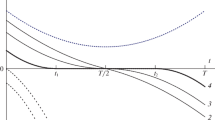Abstract
The problem of optimal control of the reorientation of a spacecraft as a solid body from an arbitrary initial position into a prescribed final angular position is considered and solved. The construction of an optimal slew control is based on the quaternionic variables and Pontryagin’s maximum principle. The case is investigated when the minimized functional combines, in a given proportion, the integral of the kinetic energy of rotation and the duration of the maneuver. On the basis of necessary optimality conditions, the main properties, laws, and key characteristics (parameters, constants, integrals of motion) of the optimal solution of the control problem, including the maximum kinetic energy for the optimal motion and the turn time, are determined. It is proved that during the optimal rotation, the direction of the kinetic moment is constant in the inertial coordinate system. Formalized equations and expressions for the synthesis of the optimal rotation program are obtained. The optimal solution corresponds to the strategy “acceleration–rotation by inertia–braking”. An assessment is made of the influence of the limiting control moment on the character of the optimal motion and on the quality control indicators. It is shown that the accepted optimality criterion guarantees the motion of a spacecraft with a kinetic rotational energy not exceeding the required value. For dynamically symmetric spacecraft, a complete solution of the reorientation problem in closed form is presented. An example and results of mathematical modeling of the motion of a spacecraft with optimal control are given, demonstrating the practical feasibility of the method for controlling spacecraft spatial orientation.
Similar content being viewed by others
References
Branets, V.N. and Shmyglevskii, I.P., Primenenie kvaternionov v zadachakh orientatsii tverdogo tela (Quaternions Application for Problems on Orientation of Rigid Body), Moscow: Nauka, 1973.
Alekseev, K.B. and Bebenin, G.G., Upravlenie kosmicheskimi letatel’nymi apparatami (Control for Spacecrafts), Moscow: Mashinostroenie, 1974.
Branets, V.N., Chertok, M.B., and Kaznacheev, Yu.V., Optimal turn of rigid body with one axis of symmetry, Kosm. Issled., 1984, vol. 22, no. 3, pp. 352–360.
Li, F. and Bainum, P.M., Numerical approach for solving rigid spacecraft minimum time attitude maneuvers, J. Guid., Control, Dyn., 1990, vol. 13, no. 1, pp. 38–45.
Scrivener, S. and Thompson, R., Survey of time-optimal attitude maneuvers, J. Guid., Control, Dyn., 1994, vol. 17, no. 2, pp. 225–233.
Chelnokov, Yu.N., Attitude control for spacecraft using quaternions, Kosm. Issled., 1994, vol. 32, no. 3, pp. 21–32.
Chelnokov, Yu.N., Quaternion synthesis for nonlinear attitude control of moving object, Izv. Akad. Nauk, Teor. Sist. Upr., 1995, no. 2, pp. 145–150.
Liu, S. and Singh, T., Fuel/time optimal control of spacecraft maneuvers, J. Guid., 1996, vol. 20, no. 2, pp. 394–397.
Shen, H. and Tsiotras, P., Time-optimal control of axi-symmetric rigid spacecraft with two controls, J. Guid., Control, Dyn., 1999, vol. 22, no. 5, pp. 682–694.
Ermoshina, O.V. and Krishchenko, A.P., Synthesis of programmed controls of spacecraft orientation by the method of inverse problem of dynamics, J. Comput. Syst. Sci. Int., 2000, vol. 39, no. 2, pp. 313–320.
Velishchanskii, M.A., Krishchenko, A.P., and Tkachev, S.B., Synthesis of spacecraft reorientation algorithms using the concept of the inverse dynamic problem, J. Comput. Syst. Sci. Int., 2003, vol. 42, no. 5, pp. 811–818.
Malanin, V.V. and Strelkova, N.A., Optimal’noe upravlenie orientatsiei i vintovym dvizheniem tverdogo tela (Optimal Control for Orientation and Helicoidal Motion of Rigid Body), Moscow, Izhevsk: Regulyarnaya i Haoticheskaya Dinamika, 2004.
Molodenkov, A.V. and Sapunkov. Ya.G., A solution of the optimal turn problem of an axially symmetric spacecraft with bounded and pulse control under arbitrary boundary conditions, J. Comput. Syst. Sci. Int., 2007, vol. 46, no. 2, pp. 310–323.
Levskii, M.V., Control of a spacecraft’s spatial turn with minimum value of the path functional, Cosmic Res., 2007, vol. 45, no. 3, pp. 234–247.
Levskii, M.V., Pontryagin’s maximum principle in optimal control problems of orientation of a spacecraft, J. Comput. Syst. Sci. Int., 2008, vol. 47, no. 6, pp. 974–986.
Molodenkov, A.V. and Sapunkov, Ya.G., Special control regime in the problem of optimal turn of an axially symmetric spacecraft, J. Comput. Syst. Sci. Int., 2010, vol. 49, no. 6, pp. 891–899.
Levskii, M.V., On optimal spacecraft damping, J. Comput. Syst. Sci. Int., 2011, vol. 50. no. 1, pp. 144–157.
Biryukov, V.G. and Chelnokov, Yu.N., Construction of optimal laws of variation of the angular momentum vector of a rigid body, Mech. Solids (Engl. Transl.), 2014, vol. 49, no. 5, pp. 479–494.
Molodenkov, A.V. and Sapunkov, Ya.G., Analytical approximate solution of the problem of a spacecraft’s optimal turn with arbitrary boundary conditions, J. Comput. Syst. Sci. Int., 2015, vol. 54, no. 3, pp. 458–468.
Chelnokov, Yu.N., Theory of kinematic control of rigid body motion, Mekhatronika, Avtom., Upr., 2017, vol. 18, no. 7, pp. 435–446.
Chelnokov, Yu.N., Applications for theory of kinematic control of rigid body motion, Mekhatronika, Avtom., Upr., 2017, vol. 18, no. 8, pp. 532–542.
Pontryagin, L.S., Boltyanskii, V.G., Gamkrelidze, R.V., and Mishchenko, E.F., Matematicheskaya teoriya optimal’nykh protsessov (Mathematical Theory of Optimal Processes), Moscow: Nauka, 1983.
Young, L.C., Lectures on the Calculus of Variations and Optimal Control Theory, Philadelphia, PA: Saunders, 1969.
Markeev, A.P., Teoreticheskaya mekhanika (Theoretical Mechanics), Moscow: Nauka, 1990.
Bertolazzi, E., Biral, F., and Da Lio, M., Symbolic-numeric efficient solution of optimal control problems for multibody systems, J. Comput. Appl. Math., 2006, vol. 185, no. 2, pp. 404–421.
Kumar, S., Kanwar, V., and Singh, S., Modified efficient families of two and three-step predictor-corrector iterative methods for solving nonlinear equations, J. Appl. Math., 2010, vol. 1, no. 3, pp. 153–158.
Levskii, M.V., RF Patent 2114771, Byull. Izobret., 1998, no. 19.
Levskii, M.V., RF Patent 2006431, Byull. Izobret., 1994, no. 2.
Levskii, M.V., RF Patent 2146638, Byull. Izobret., 2000, no. 8.
Author information
Authors and Affiliations
Corresponding author
Additional information
Russian Text © The Author(s), 2018, published in Prikladnaya Matematika i Mekhanika, 2018, Vol. 82, No. 6, pp. 690–705.
About this article
Cite this article
Levskii, M.V. Optimal Control of a Spacecraft Orientation Taking into Account the Energy of Rotation. Mech. Solids 54, 144–156 (2019). https://doi.org/10.3103/S0025654419030166
Received:
Published:
Issue Date:
DOI: https://doi.org/10.3103/S0025654419030166



